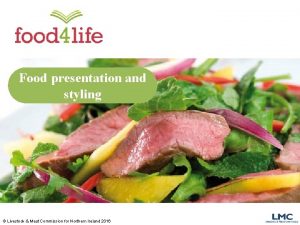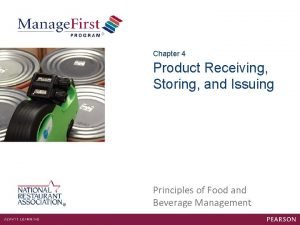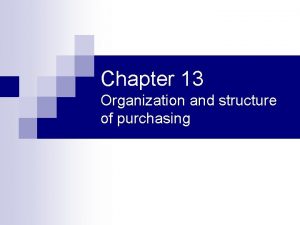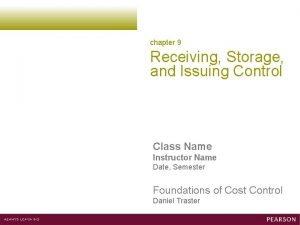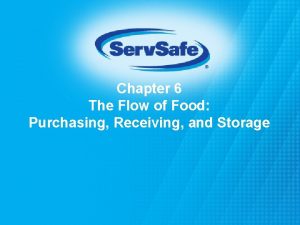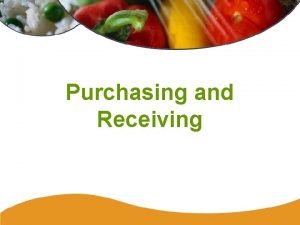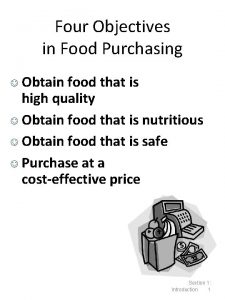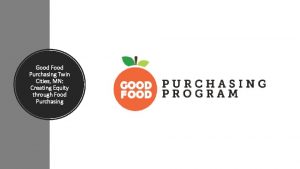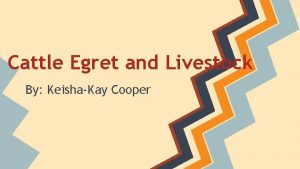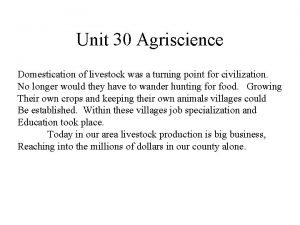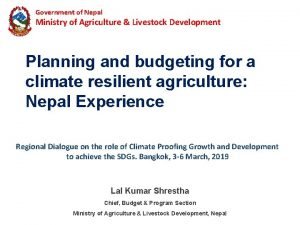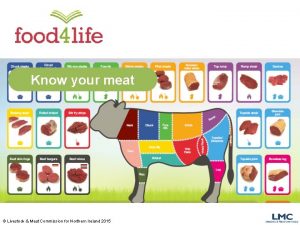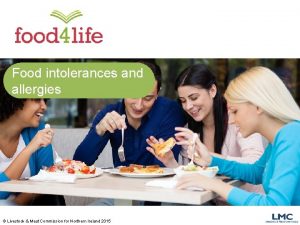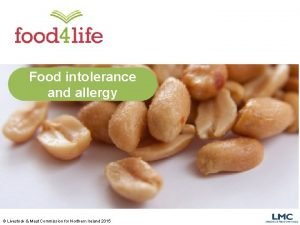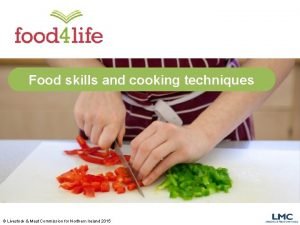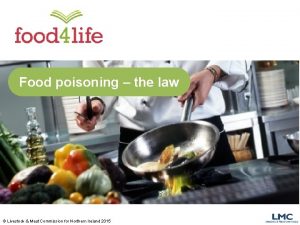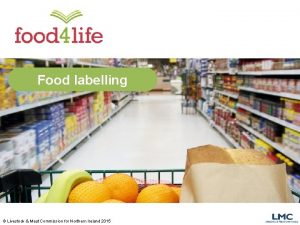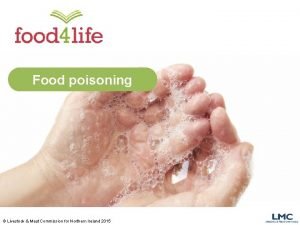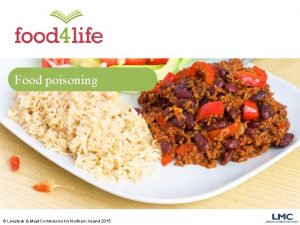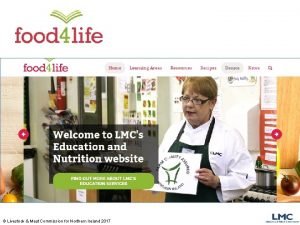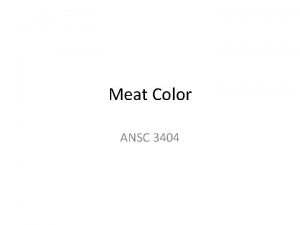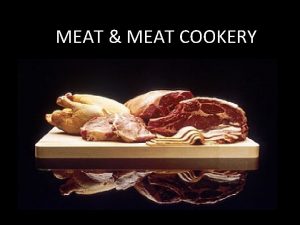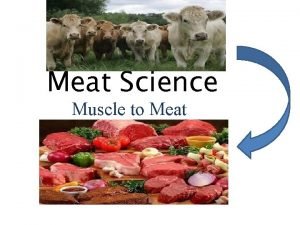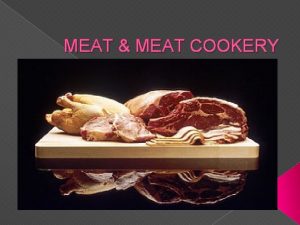Purchasing and storing food Livestock Meat Commission for
















- Slides: 16

Purchasing and storing food © Livestock & Meat Commission for Northern Ireland 2015

Learning Objectives • To explain how to use food labels to purchase food that is safe to eat. • To identify good practice when shopping for and transporting food. • To describe effective and safe storage procedures for food. © Livestock & Meat Commission for Northern Ireland 2015

Look for Quality The Northern Ireland farm Quality Assurance Scheme is a code of practice operated by beef and sheep farmers. It is recognised at home and abroad as a symbol of the quality and character of the farm on which your meat is produced. It gives the consumer the best possible assurances that it will be as safe, healthy and wholesome as possible. © Livestock & Meat Commission for Northern Ireland 2015

Purchasing food Carefully checking the labels on foods and following the instructions is an important way to reduce your chances of becoming ill through food poisoning. © Livestock & Meat Commission for Northern Ireland 2015

Date labels – Use by dates Foods which spoil quickly (i. e. are highly perishable) such as cooked meat and fish have a ‘Use by’ date. If kept for too long these foods can cause food poisoning even though they may not taste odd. Foods with a ‘Use by’ date should not be eaten after this date. © Livestock & Meat Commission for Northern Ireland 2015

Date labels – Best before dates Other foods have a ‘best before’ date, after which foods may not be at their best, with regard to flavour, colour and texture, even though they will probably be safe if they have been stored according to the instructions on the label. © Livestock & Meat Commission for Northern Ireland 2015

Best before dates and eggs Previously, as eggs can contain the harmful bacteria salmonella, the advice was not to eat them after their ‘best before date’. However, as part of a drive to cut food waste, the Food Standards Agency has revised its advice on using eggs after their ‘best before’ date. The advice now is that, providing the eggs are cooked thoroughly, e. g. in a cake or so that the white and yolk are hard they can be eaten a day or two after their ‘best before’ date. © Livestock & Meat Commission for Northern Ireland 2015

Freezing star rating system A simple star system is used on food labels to indicate what temperature the food should be held at and for how long: • • * - 6 º C 1 week (pre-frozen food only); ** - 12 º C 1 month (pre-frozen food only); *** - 18 º C 3 months (pre-frozen food only); **** - 18 º C or colder 6 months (pre-frozen food; can also be used to freeze fresh food from room temperature). © Livestock & Meat Commission for Northern Ireland 2015

Preparation and cooking food – on the label Instructions on how to prepare and cook the food must be given on the label, if they are needed. If the food has to be heated, the temperature of the oven and the cooking time will usually be stated. Instructions may also be given for heating in a microwave oven. These instructions should make sure that the food tastes its best and that it will be thoroughly heated to a core temperature of 70ºC to help minimise the risk of food poisoning. © Livestock & Meat Commission for Northern Ireland 2015

Shopping and taking your food home In order to prevent bacterial multiplication it is important to keep your chilled and frozen food as cold as possible whilst you are shopping and travelling home. © Livestock & Meat Commission for Northern Ireland 2015

Shopping and taking your food home Some suggestions are: • Choose your chilled and frozen food at the end of your shopping trip; • Always ensure that meat and poultry and properly wrapped up and even store in a separate bag; • Use a cool bag and ice blocks and pack chilled and frozen foods together; • Get your shopping home and into a fridge or freezer as soon as you can. © Livestock & Meat Commission for Northern Ireland 2015

Storing food When storing food, always remember that food should be stored: • • At the correct temperature; Under the right conditions; For the correct time; And always read the instructions! © Livestock & Meat Commission for Northern Ireland 2015

Storing food – in the fridge When storing food in the fridge, it should be stored as follows: • Top shelf – dairy foods (low risk foods); • Next shelf – cooked meats; • Next shelf – raw meat and fish, in a container and covered to prevent cross-contamination through drips; • Bottom – salad, fruit and vegetables. Activity: To learn more and better understand refrigerated storage, why not try out our Interactive Fridge: http: //www. food 4 life. org. uk/games/fridge © Livestock & Meat Commission for Northern Ireland 2015

Storing food – in the fridge • Keep it at the right temperature (between 05°C). • Keep the fridge door closed as much as possible. • Wait for food to cool down before it is placed in the fridge. • Do not overload the refrigerator. If the fridge is full, the cool air will not circulate around the food. Food should be covered to prevent cross contamination and moisture loss. • Clean to removed spills and food deposits whenever they occur to prevent contamination of food. • Clean the fridge regularly – ideally once a week. © Livestock & Meat Commission for Northern Ireland 2015 *below 5°C is the recommended temperature for good practice but 8°C is the legal maximum temperature for cold storage

Storing food – in the freezer • Ensure the freezer is working at a temperature below -18 °C. • Do not place hot foods in the freezer or leave the door open for extended periods. • Do not overload the freezer. Cold air needs to circulate around the food. • Store food with a label showing the contents and the date. Food should be wrapped well to prevent it drying out. • Only freeze food when at its best condition, to allow the food to last longer. • Keep the freezer clean by removing spills and food deposits when they occur. • Never refreeze defrosted food, as this increases the growth of bacteria. © Livestock & Meat Commission for Northern Ireland 2015

Acknowledgement For further information, go to: www. food 4 life. org. uk © LMC 2015 © Livestock & Meat Commission for Northern Ireland 2015
 Livestock meat commission
Livestock meat commission Issuing products
Issuing products Purchasing organizational structure
Purchasing organizational structure Emergency purchase
Emergency purchase Food storing and issuing control
Food storing and issuing control Kind of poultry
Kind of poultry Commissions and graduated commissions 1
Commissions and graduated commissions 1 The flow of food purchasing receiving and storage
The flow of food purchasing receiving and storage Servsafe food storage diagram
Servsafe food storage diagram Defects of secondary education commission 1952-53
Defects of secondary education commission 1952-53 Receiving in food flow
Receiving in food flow Food objectives
Food objectives Zoe hollomon
Zoe hollomon Cattle egret and cattle symbiotic relationship
Cattle egret and cattle symbiotic relationship Livestock breed identification swine - vocabulary
Livestock breed identification swine - vocabulary Ministry of agriculture and livestock development
Ministry of agriculture and livestock development Unit 2 food food food
Unit 2 food food food
